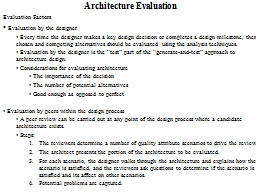

Factors Evaluation by the designer Every time the designer makes a key design decision or completes a design milestone then chosen and competing alternatives should be evaluated using the analysis techniques ID: 1018902
Download Presentation The PPT/PDF document "Architecture Evaluation Evaluation" is the property of its rightful owner. Permission is granted to download and print the materials on this web site for personal, non-commercial use only, and to display it on your personal computer provided you do not modify the materials and that you retain all copyright notices contained in the materials. By downloading content from our website, you accept the terms of this agreement.
1. Architecture EvaluationEvaluation Factors Evaluation by the designer Every time the designer makes a key design decision or completes a design milestone, then chosen and competing alternatives should be evaluated using the analysis techniques. Evaluation by the designer is the “test” part of the “generate-and-test” approach to architecture design. Considerations for evaluating architecture The importance of the decision The number of potential alternatives Good enough as opposed to perfect Evaluation by peers within the design process A peer review can be carried out at any point of the design process where a candidate architecture exists. Steps:The reviewers determine a number of quality attribute scenarios to drive the review.The architect presents the portion of the architecture to be evaluated.For each scenario, the designer walks through the architecture and explains how the scenario is satisfied, and the reviewers ask questions to determine if the scenario is satisfied and its affect on other scenarios.Potential problems are captured.
2. Architecture EvaluationEvaluation Factors Analysis by outsides once the architecture has been design In principle, an outside team may evaluate a complete architecture, an incomplete architecture, or a portion of an architecture. In practice, because engaging them is complicated and often expensive, they tend to be used to evaluate complete architectures. Context factors What artifacts are available Who sees the results (private or public) Who perform the evaluation Which stakeholders will participate What are the business goals
3. Architecture EvaluationThe Architecture Tradeoff Analysis Method (ATAM) Participants in the ATAM The evaluation team Project decision makers Architecture stakeholders (developers, testers, integrators, maintainers, performance engineers, users, builders of external systems which will communicate this system, etc.
4. Architecture EvaluationThe Architecture Tradeoff Analysis Method (ATAM) Outputs of the ATAM A concise presentation of the architecture Articulation of the business goals Prioritized quality attribute requirements expressed as quality attribute scenarios A set of risks and nonrisks Risk: an architectural decision that may lead to undesirable consequences in light of stated quality attribute requirements. A set of risk themes Risk themes: overarching themes that identify systemic weakness in the architecture or even the architecture process and team. If left untreated, these risk themes will threaten the project’s business goals. Mapping of architectural decisions to quality attributes A set of identified sensitivity and tradeoff pointsSensitivity point: decision made for this point in the architecture design will affect satisfaction of certain quality attribute(s).Tradeoff point: tradeoff is needed when making decision to satisfy two or more quality attributes at this point in the architecture design.
5. Architecture EvaluationThe Architecture Tradeoff Analysis Method (ATAM) Phases of the ATAM
6. Architecture EvaluationThe Architecture Tradeoff Analysis Method (ATAM) Steps of the evaluation phases Step 1: Present the ATAM Step 2: Present the business drivers The system’s most important functions Any relevant technical, managerial, economic, or political constraints The business goals and context as they relate to the project the major stakeholders The architectural drivers or ASRs. Step 3: Present the architecture Context diagram Module or layer view Component-and-connector view Deployment view Architectural patterns and tactics employed and associated quality attributes Use of reusable, commercial off-the-shelf (COTS) products 1-3 important use cases 1-3 important change scenarios Architectural issues/risks with respect to meeting the driving architectural requirements
7. Architecture EvaluationThe Architecture Tradeoff Analysis Method (ATAM) Steps of the evaluation phases Step 4: Identify architecture approaches catalog the patterns and tactics that have been identified. Step 5: Generate quality attribute utility tree Step 6: Analyze architectural approaches
8. Architecture EvaluationThe Architecture Tradeoff Analysis Method (ATAM) Steps of the evaluation phases Step 7: Brainstorm and prioritize scenarios Step 8: Analyze architectural approaches (again) After the scenarios have been collected and prioritized, the evaluation team guides the architect in the process of carrying out the highest ranked scenarios. In this step, the evaluation team performs the same activities as in step 6, using the highest-ranked, newly generated scenarios. Typically, this step might cover the top 5-10 scenarios as time permits. Step 9: Present results The evaluation team groups risks into risk themes, based on some common underlying concern or systemic deficiency. For each risk theme, the evaluation team identifies which of the business drivers are affected. The collected information from the evaluation is summarized and presented to stake holders: The architectural approaches documented The set of scenarios and their prioritization form the brainstorming The utility tree The risks discovered The nonrisks documented The sensitivity points and tradeoff points found Rick themes and the business drivers threatened by each one
9. Architecture Evaluation Lightweight Architecture Evaluation